- Author Matthew Elmers [email protected].
- Public 2023-12-16 21:49.
- Last modified 2025-01-24 09:17.
"On the palm embankment, he got everything that was due to him."
("Treasure Island" by R. L. Stevenson)
There are all kinds of castles in the world: large and small, erected in the mountains and built on the plains, destroyed and rebuilt, beautiful and not very beautiful, in a word, none of them is like the other. Here is the Larnaca Castle, located in the southern part of the embankment of the Cypriot city of Larnaca, which is called the Finikoudes Promenade (that is, the Date Promenade), although not large in size, but also interesting in its own way.
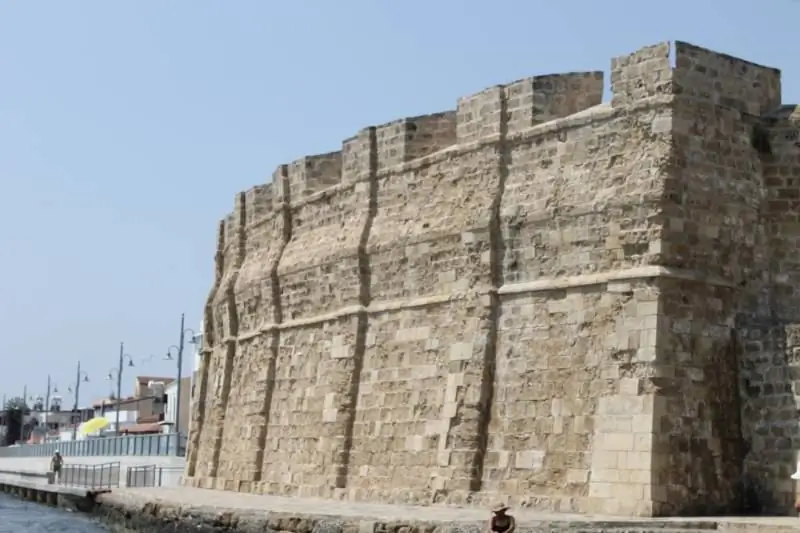
Here it is - the highest, facing the sea, the southern bastion of the Larnaca castle, which has seen so many people and ships!
According to historical evidence that has come down to us, the castle in the harbor of Larnaca was built during the reign of King James I of Lusignan (1382-1398) in Cyprus. The fortress was part of the defensive system of the southern coast of the island, stretching from the port of Famagusta in the east through the promontory in the Pila and Limassol region to the Akrotiri Bay.
During the rule of the Venetians on the island (1489-1571), the castle still defended the port of Larnaca, well, but in 1625, when the island began to belong to the Turks, they restored it in the form it has today (as the sign above the entrance tells about), strangely combining features of both Romanesque and Ottoman architecture. But by the 18th century, it was again partially destroyed.
It is believed that the size of that castle was slightly larger than the modern one, which is proved by the medieval foundations discovered during the renovation work, going north and south-west under the modern highway. The shape of the arches preserved in the castle directly indicates the time of their construction, namely, the XIV century. That is, in essence, the structure is very ancient. Well, today it is a tourist site that, probably, none of the tourists visiting Larnaca and strolling along the "Date Alley" will miss.
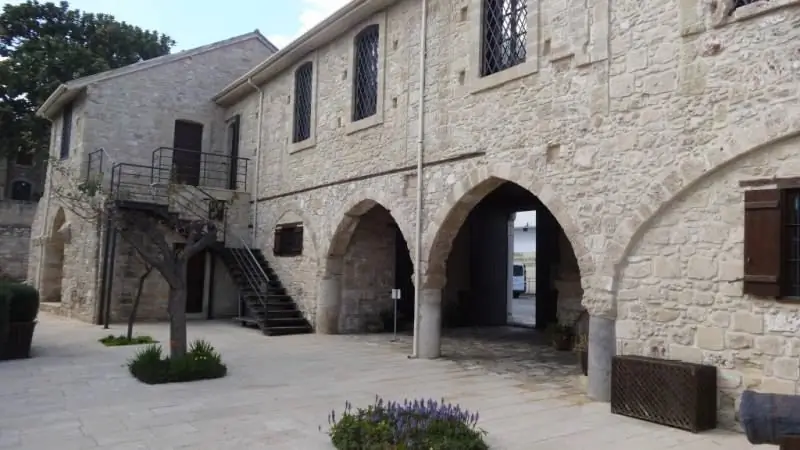
Entrance view (from inside) and ground floor.
Firstly, all the buses running along the coast come here. Secondly, how not to stroll along this flat, like an arrow embankment, with the sea and the beach on the left, and rows of hotels, shops on the right, in a word - all that bright, colorful and alluring, why people come here. And this is how you will walk, walk and be sure to run into an old, stone wall, eaten by time, be sure to take a picture near it, and you will want to see “what's behind the wall”!
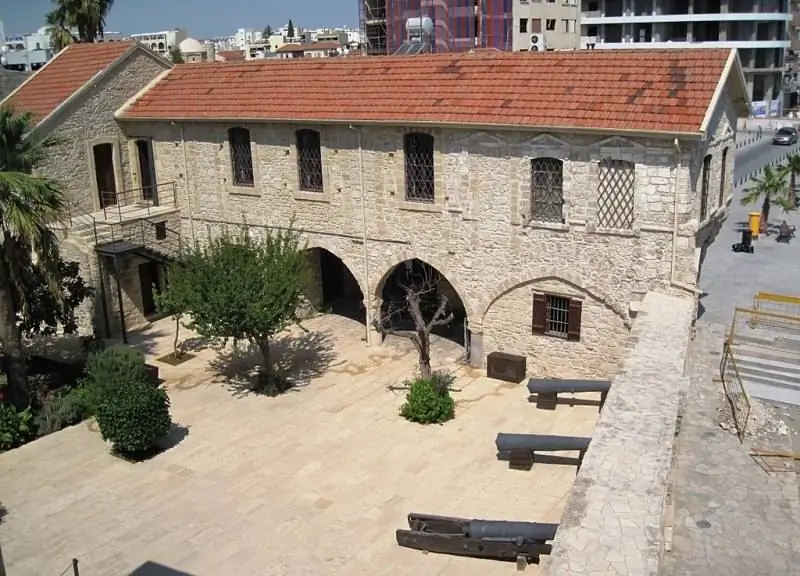
This is the same building as seen from the wall.
I must say that a truly beautiful castle wall overlooks the beach, so in order to photograph it from a distance from the sea, you will have to go into the water. The entrance to the castle is located on the east side, in a two-story building, built during the period of Turkish rule, as evidenced by both its architectural form and the inscription above the entrance, made in Turkish.
Once inside the castle (the entrance is inexpensive, only 2.5 euros, besides, you will also be given a colorful booklet in Russian!) You will see a large courtyard, which has enough light and greenery, that is, you will have where to rest and shelter from the heat.
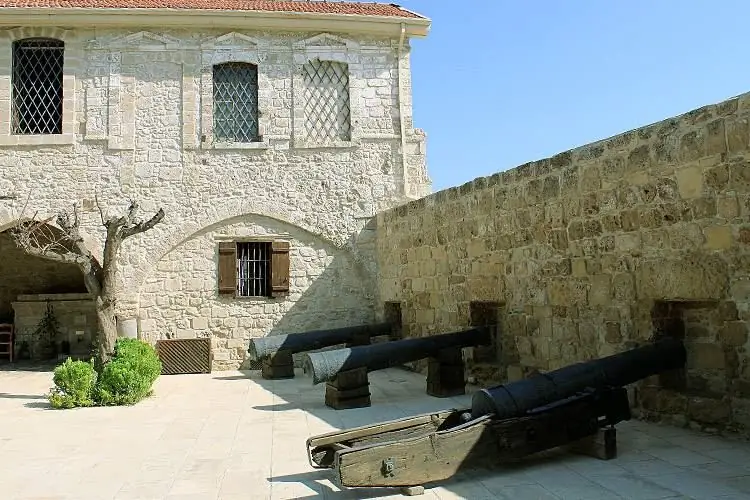
And this is a "collection of guns"
In the basement floor of the building there are two halls - west and east, between which is the entrance to the courtyard. In the western hall, the British executed (hanged) convicts until 1948, and there is a corresponding exposition there, which I did not even begin to photograph. Here you can climb the stairs to the second floor, where the District Museum of the Middle Ages is located - quite interesting, but too poor and not impressive. In the northern part of the eastern wing of the castle is a battery of several thoroughly rusted old cannons, somewhat exaggeratedly referred to in the guide as the "collection of cannons". The southern part of the east wing is a rectangular building, consisting of a number of rooms, which are covered with a pointed Gothic arch. Here are exhibited tombstones from the 14th century, brought here from the Gothic cathedrals in Nicosia.
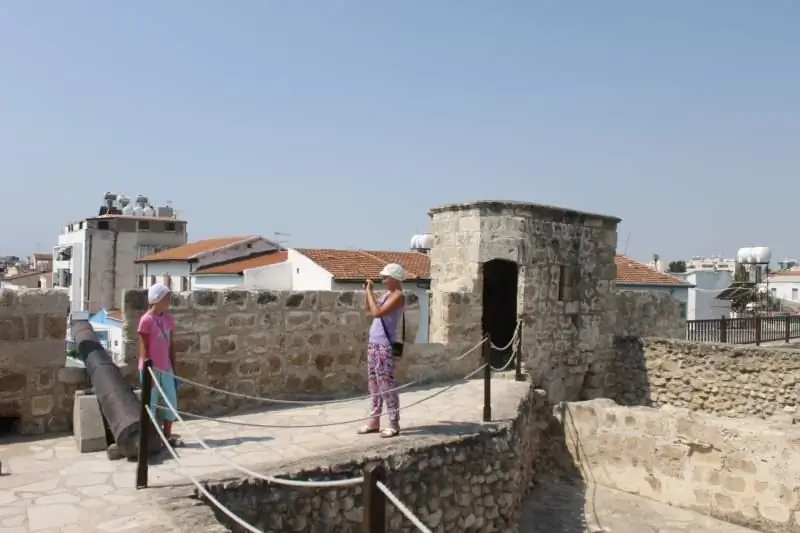
There are also cannons on the roof of the south wing and, of course, there are many tourists who are photographed against their background. "My Child and the Cannon" is a very popular story.
In the western part of the south wing there is a staircase leading to the roof of this building and also to the museum located on the second floor. These are the oldest parts of the castle, united with the main building by a high wall. The museum has four rooms, in the first of which you can see architectural fragments from early Christian basilicas of the 4th-7th centuries. In the second room, ancient artifacts of the same time are presented, and again these are molded decorations from ancient basilicas, various clay lamps, glass and earthenware, stone stamps for bread products and inscriptions on marble. On the walls there are old photographs of early Christian, Byzantine and post-Byzantine monuments of Cyprus in the 4th-16th centuries, taken in the 19th and early 20th centuries. In a small central, third in a row, photographs of wall paintings from the Byzantine era in the history of Cyprus, which date back to the XI-XVI centuries, are displayed. So for those interested in the history of Byzantium, there is something to see here, but overall nothing particularly impressive.
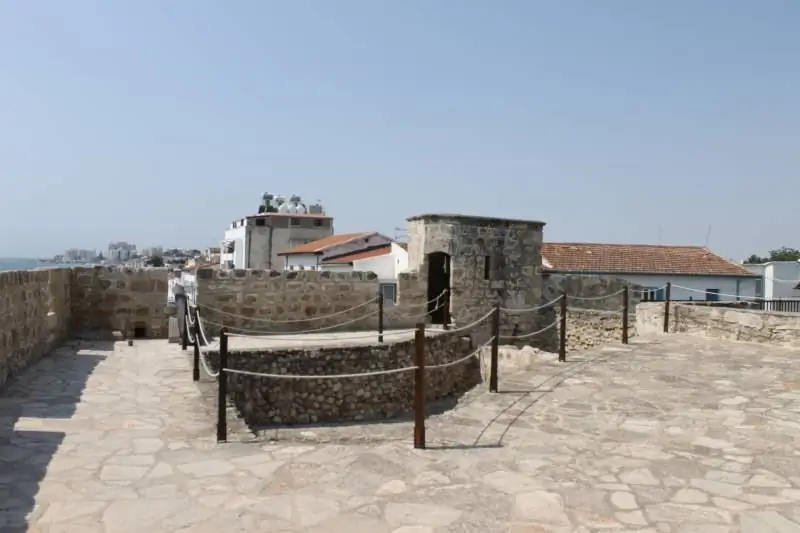
Roof. I barely waited for everyone to leave …
In the large rectangular hall No. 4, samples of medieval glazed ceramics of the 12th-18th centuries, metal dishes and firearms of the 18th-19th centuries, as well as helmets and swords of the 15th-16th centuries are exhibited. But no matter how hard I tried, I was so unable to photograph any of this. And the showcases are inconvenient, and the lighting is inappropriate, in a word, you can see it, but hardly anything you can take with you!
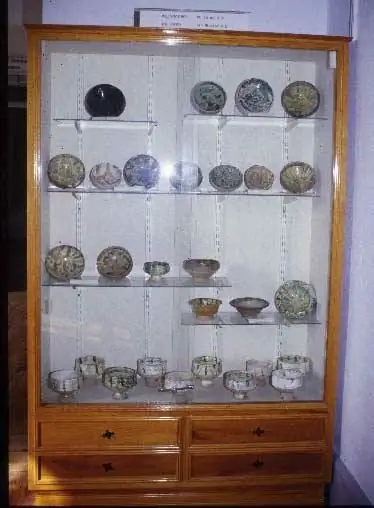
Photo of a cabinet with ceramic dishes.
Again, there are many photographs of architectural monuments of the island of the Gothic and Renaissance era (XIII-XVI centuries). The eastern part of this hall is a typical living room of the Turkish period (XVIII-XIX centuries), but it is somehow strange and, in my opinion, it is simply impossible to live in it. The only thing you can do in this room is, excuse me, to lie belly up and smoke a hookah!
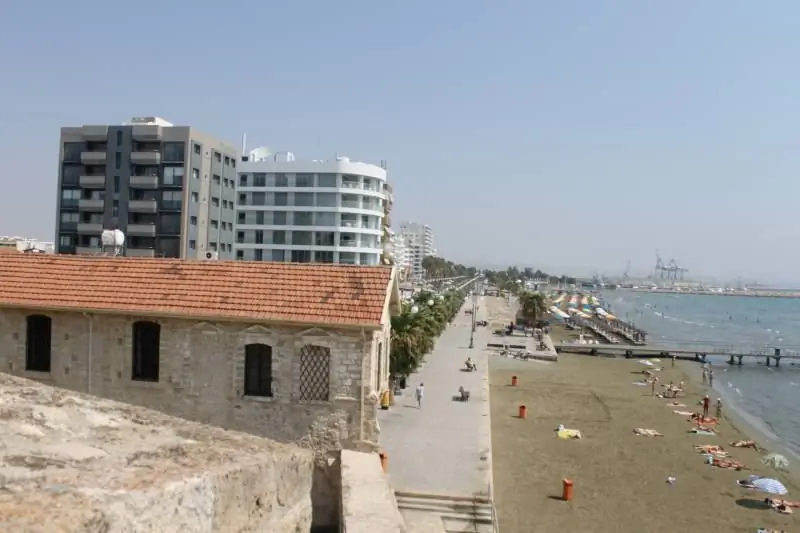
And here is a view from the southern bastion of the embankment and the beach. The sea is like off the coast of Anapa, that is, "knee-deep". But, fortunately, there are an order of magnitude less people.
Now you descend into the courtyard, which in summer is used for various urban cultural events and, first of all, theatrical performances, for example, the opera Othello by Giuseppe Verdi, which here in the castle, against the backdrop of authentic medieval walls, is perceived quite differently than in the theater. It is not surprising that they attract a lot of people and, of course, tourists.
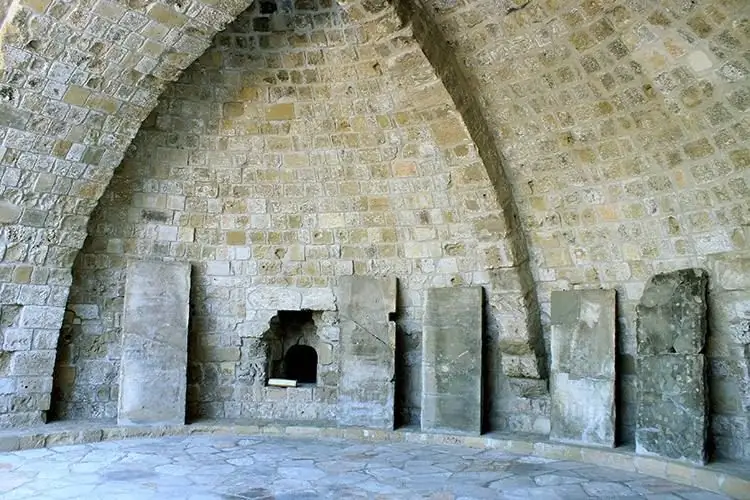
But these are the same medieval vaulted halls that are under the roof, which we just visited. And in them there are tombstones …

This slab bears the images of a shield with three crosses, but nothing more. Probably, then, in the past, everyone knew whose coat of arms it was, but today … Well, who knows?
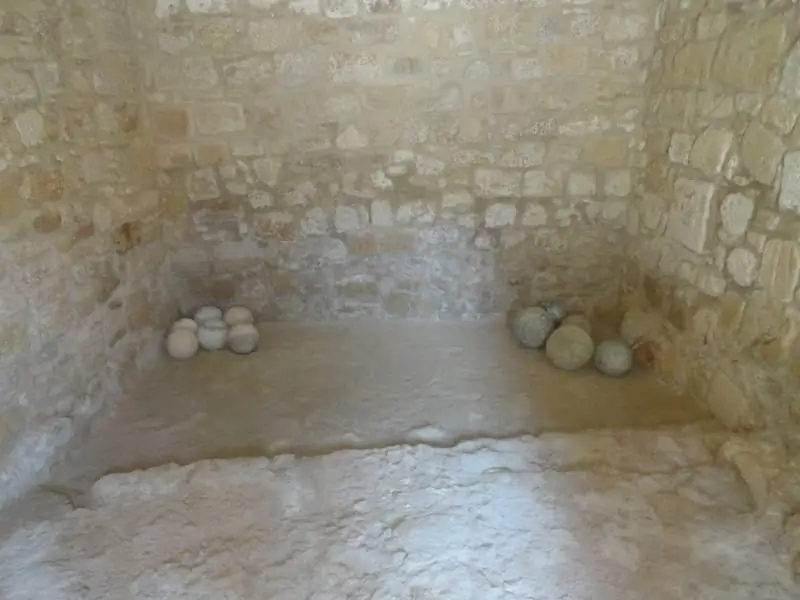
And here are stone cannonballs. But you will be wasting your time if you search here for guns of the right caliber for them. Alas, for the "artillery" presented in the castle it is "yesterday".
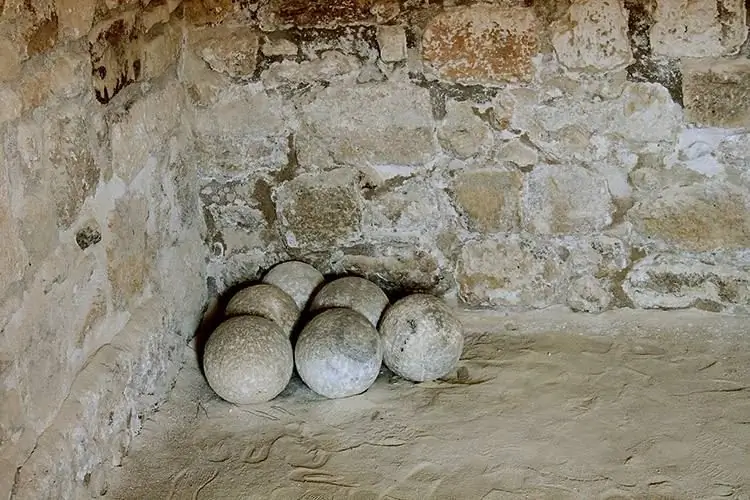
But how neat they are. And there were people who tried, cut, processed to the same size …
With the arrival of the British in 1878, the castle was renovated, after which a police station was set up in it, where the detainees were kept and the death penalty was carried out by hanging. The last such execution was carried out in 1948, after which the police station moved to the opposite end of Finikoudes Boulevard, well, and a history museum was opened in the castle.
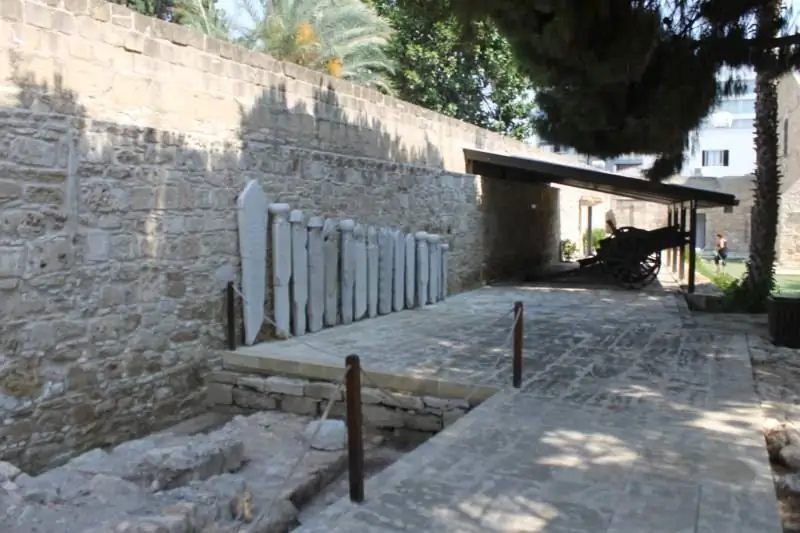
We continue bypassing the castle. This is the north wall. There are interesting Muslim tombstones near it.
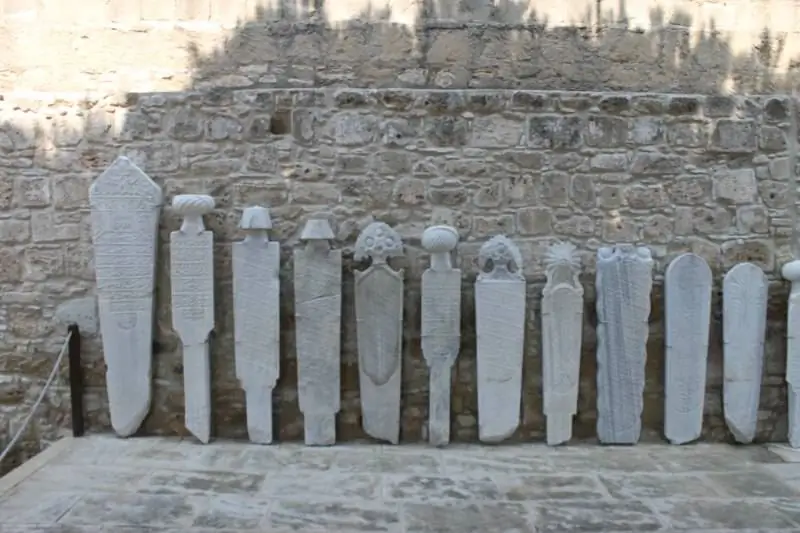
Here they are in close-up.
But in 1963, during the riots that broke out in the city, some of the museum exhibits were stolen or badly damaged. So then the exposition had to be reassembled, hence all of its strange, motley character. However, for Larnaca this is just typical, as typical and - I would say, the chamber nature of this castle-museum. It is not clear, by the way, how the defense was held here at all. A couple of mortar bombs and … you can kill half of the garrison or shell shock. But this is so, by the way. And in Larnaca itself there is also a very intimate "Museum of Owls", where stuffed owls and their carvings are exhibited, a museum of medicine, which is open all two days a week, but for specialists it is very interesting, an archaeological museum in only three rooms, but with a large exposition on the street, an art gallery, some private museums, where it is not clear what and why, but … it is exhibited, nevertheless. And even a very tiny archive with interesting documents and maps … only for researchers! So everything is for tourists! Tired of frying on the beach - go and see, all the income!
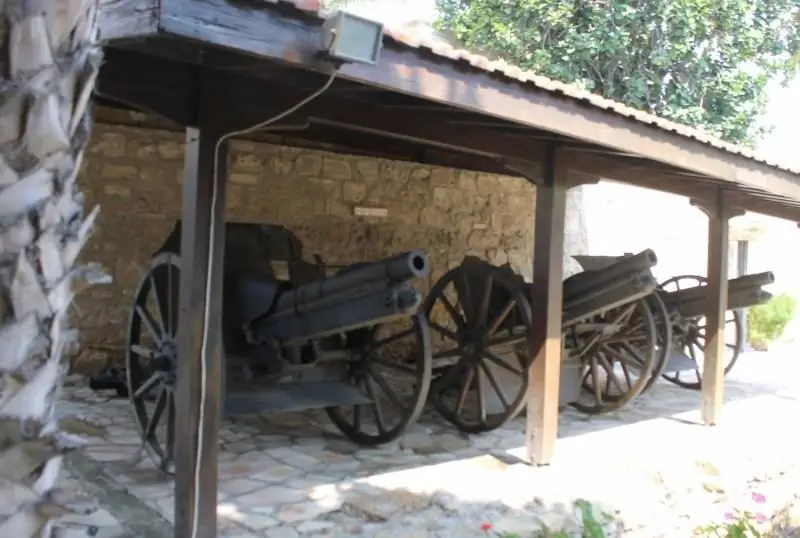
Here, under a canopy, there are 122-mm Krupp howitzers, but they are so broken and rusty that I did not take them off on a larger scale.
In general, you will be walking along the embankment of Larnaca - be sure to go to this castle. Summer is coming soon, and why - if, of course, you are planning to go to Cyprus, not to see this attraction of it ?!

But what is especially good in Cyprus is the taxi. Six doors and very spacious inside. Taxis "our size" are not found there. Only such. Therefore, the profession of a taxi driver is highly respected. Well, of course - to buy, maintain, and ride on this …






